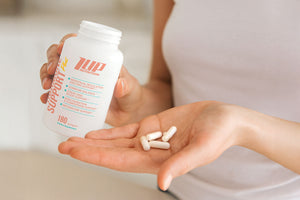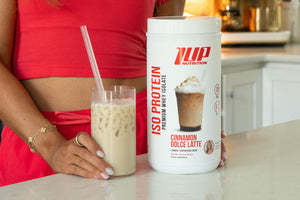Just about any health and fitness expert will agree that fruits are a key component to a healthy diet, and it’s easy to understand why — they are nutrition powerhouses chock-full of all sorts of vitamins, minerals, antioxidants and other micronutrients which support performance, recovery, and overall wellness.
That being said, some fruits may be better than others, especially if you are concerned with weight loss.
The reason for this is that while fruits are incredibly healthy, some of them can deliver considerable amounts of sugar with little to no fiber. This can wreak havoc on your blood sugar and insulin levels, setting you on the path to hunger pangs coupled with a rather rough energy roller coaster (due to the blood sugar spikes and eventual falls).
To help you on your journey to lose weight, get healthy, and upgrade your nutrition plan, we’ve assembled a list of our top 5 best and worst fruits for weight loss.
Top 5 Best Fruits for Weight Loss
Berries
Berries are rockstars of the fruit world. They’re low in calories, high in fiber, and packed with antioxidants, polyphenols, and anthocyanins, which have been noted in research to help combat a number of chronic conditions including diabetes, metabolic syndrome, obesity, neurodegeneration, and cardiovascular disease.[1]
One cup of strawberries (140 grams) contains only 50 calories while delivering 3 grams of dietary fiber, close to a third of your daily requirement for manganese, and 150% of the RDI for vitamin C![2]
Berries may support weight loss as some research indicates that having a snack of mixed berries between meals (as opposed to candy) may help you eat less food at subsequent meals.[2]
To top it off, berries may also help reduce cholesterol levels, decrease blood pressure, and lower inflammation.[3]
If berries aren’t in season where you live, frozen berries are available year round and are an affordable and versatile way to get your daily serving of berries in. Frozen berries make great additions to oatmeal, smoothies, and protein pancakes.
Grapefruit
Grapefruit is another great low glycemic, low-calorie option for those who want to eat fruit even while dieting. ½ a grapefruit contains only around 40 calories, yet it provides over 60% of your daily requirement for Vitamin C along with 28% of the RDI for vitamin A.
It may also help weight loss too, as a 12 week study found that eating grapefruit before meals helped reduce calorie intake and improve cholesterol levels.[4] Subjects in the study even experienced an average 7.1% decrease in body weight.[4]
These findings are bolstered by a recent review which noted that grapefruit consumption helps decrease body fat, waist circumference, and blood pressure.[5]
Grapefruits can be a great side dish for your morning breakfast or make for a sublime addition to salads topped with grilled chicken.
Melons
Another summertime favorite fruit are melons.
Honeydew, cantaloupe and watermelon are just a few of the many varieties of melon you’ll find at the market, and each is packing some serious micronutrient power while keeping calories and sugar in check.
Your average cup of melon contains only 45 to 60 calories, while supplying generous amounts of potassium, fiber, vitamin C, and powerful antioxidants such as lycopene and beta-carotene.[6]
Melons also have a high water content which supports hydration, helps keep you feeling full, and may even help you shed unwanted weight.[7]
Avocados
Believe it or not, avocados are actually a fruit and not a vegetable!
Aside from being the base for one of the greatest dips ever created (guacamole), avocados are also a nutrition behemoth (high in potassium, fiber, folate, and vitamin K) as well as incredible rarity in the world of fruits as they actually contain a good deal of dietary fat.
While that might make avocados seem out of bounds for those cutting, avocados are rich in heart-healthy monounsaturated fats, and they even pack a decent amount of plant-based protein to help keep you feeling full and less likely to overeat at mealtime.
Various studies have found that eating avocados can decrease appetite, increase satiety, improve cholesterol levels, and promote weight loss.[8] Other research has found that regular avocado consumption is linked to better diet quality and nutrient intake as well as a lower risk of metabolic syndrome.[9]
Apples
Apples are the ultimate on-the-go snack. They fit in the palm of your hand, contain a modest amount of calories (80-115 calories depending on size), and a generous amount of fiber to help keep you feeling full.
Interestingly, research has found that an apple may be up to 3x more satiating than a chocolate bar.[10]
Some studies even indicate apples may help reduce your risk for certain chronic diseases and promote heart health, likely due to their high antioxidant activity.[11]
Now that we’ve discussed 5 of the best fruits to consume while cutting, let’s turn our attention to 5 fruits you want to limit (or avoid entirely) when dieting for weight loss.
Top 5 Worst Fruits for Weight Loss
Canned Fruit
Processed goods typically contain added sugars, and canned fruit is no exception. When fruits are canned, they’re usually packed in heavy syrup which is nothing more than sugar and water.
Additionally, the canning process may also decrease the micronutrient content of the fruit due to the application of heat during manufacturing.
Canned or packaged fruit can serve as a fallback in a bind, but make sure to get the varieties packed in water, not syrup.
Dried Fruit
Gram for gram, dried fruit is more calorically dense than whole fresh fruit. When you dry fruit, the water is removed which concentrates the sugar per serving. This also means that dried fruit is likely less filling since it’s missing the water component of fresh fruit which helps keep you hydrated and feeling fuller.
To top it off, most dried fruits you’ll find at the store have added sugars and oils, which ratchet up the calorie count without offering much in the way of added nutrition.
Fruit Juices
Juice bars are all the rage these days, and the demand for cold-pressed juices continues to climb. But, don’t be fooled by those 5-day juice cleanses or detoxes.
While tasty and refreshing on a hot summer day, fruit juice shouldn’t be on the top of your food list if you’re trying to lose weight. The reason for this is that fruit juice is glorified sugar water. It’s high in calories and sugar and devoid of the belly-filling fiber that helps keep your hunger levels and blood sugar levels in check.
Mango
Tropical fruits like pineapple and mango, while delicious tend to be much higher in calories and sugar than other fruits like berries or melons. In fact, one cup of mango has over 20 grams of sugar!
Due to their ultra-sweet flavor and lower fiber content, it’s easier to overeat on them, which may cause you to consume too many calories.
Figs
Figs are delicious as part of a dessert course of fruits and cheese, but they may not be the ideal fruit to include in your diet if your focus is fat loss. The reason for this is that one small fig has roughly eight grams of sugar with only a single gram of fiber. This doesn’t bode well for blood sugar levels or helping you feel full.
Like mangos, it’s probably best to restrict your intake of these when dieting due to their high sugar and low fiber content.
BONUS!
Another healthy way to get your fruits and vegetables in is with a single serving of 1UP Organic Vegan Greens & Reds Superfood Powder. It contains two full servings of vegetables and one full serving of fruit!
Related read
References
- Afrin, S., Gasparrini, M., Forbes-Hernandez, T. Y., Reboredo-Rodriguez, P., Mezzetti, B., Varela-Lopez, A., Battino, M. (2016). Promising Health Benefits of the Strawberry: A Focus on Clinical Studies. Journal of Agricultural and Food Chemistry, 64(22), 4435–4449. https://doi.org/10.1021/acs.jafc.6b00857
- James, L. J., Funnell, M. P., & Milner, S. (2015). An afternoon snack of berries reduces subsequent energy intake compared to an isoenergetic confectionary snack. Appetite, 95, 132–137. https://doi.org/10.1016/j.appet.2015.07.005
- Basu, A., & Lyons, T. J. (2012). Strawberries, blueberries, and cranberries in the metabolic syndrome: clinical perspectives. Journal of Agricultural and Food Chemistry, 60(23), 5687–5692. https://doi.org/10.1021/jf203488k
- Silver HJ, Dietrich MS, Niswender KD. Effects of grapefruit, grapefruit juice and water preloads on energy balance, weight loss, body composition, and cardiometabolic risk in free-living obese adults. Nutr Metab (Lond). 2011;8(1):8. Published 2011 Feb 2. doi:10.1186/1743-7075-8-8
- Onakpoya, I., O’Sullivan, J., Heneghan, C., & Thompson, M. (2017). The effect of grapefruits (Citrus paradisi) on body weight and cardiovascular risk factors: A systematic review and meta-analysis of randomized clinical trials. Critical Reviews in Food Science and Nutrition, 57(3), 602–612. https://doi.org/10.1080/10408398.2014.901292
- "Food Composition Databases Show Foods -- Melons, Cantaloupe, Raw." USDA Food Composition Databases,
- Thornton SN. Increased Hydration Can Be Associated with Weight Loss. Front Nutr. 2016;3:18. Published 2016 Jun 10. doi:10.3389/fnut.2016.00018
- Pieterse, Z., Jerling, J. C., Oosthuizen, W., Kruger, H. S., Hanekom, S. M., Smuts, C. M., & Schutte, A. E. (2005). Substitution of high monounsaturated fatty acid avocado for mixed dietary fats during an energy-restricted diet: effects on weight loss, serum lipids, fibrinogen, and vascular function. Nutrition (Burbank, Los Angeles County, Calif.), 21(1), 67–75. https://doi.org/10.1016/j.nut.2004.09.010
- Fulgoni VL 3rd, Dreher M, Davenport AJ. Avocado consumption is associated with better diet quality and nutrient intake, and lower metabolic syndrome risk in US adults: results from the National Health and Nutrition Examination Survey (NHANES) 2001-2008. Nutr J. 2013;12:1. Published 2013 Jan 2. doi:10.1186/1475-2891-12-1
- Holt, S. H., Miller, J. C., Petocz, P., & Farmakalidis, E. (1995). A satiety index of common foods. European Journal of Clinical Nutrition, 49(9), 675–690.
- Boyer J, Liu RH. Apple phytochemicals and their health benefits. Nutr J. 2004;3:5. Published 2004 May 12. doi:10.1186/1475-2891-3-5






